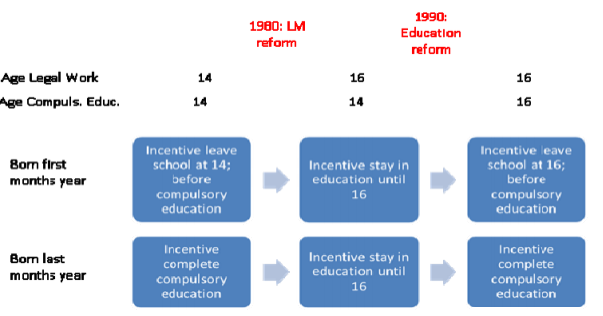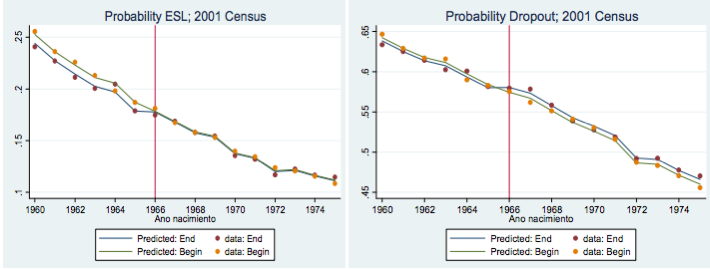What happens after a change in the statutory minimum working age? In their BSE Working Paper (No. 834), “The Effect of Changes in the Statutory Minimum Working Age on Educational, Labor and Health Outcomes,” Elena del Rey, Sergi Jiménez-Martín and Judit Vall-Castello explore the effects of a 1980 labor market reform in Spain that increased the statutory minimum working age. The authors show that the probabilities for finishing both primary and secondary school levels increase for individuals born at the beginning of the year and affected by the reform.
The 1980 reform of the minimum statutory working age in Spain
Most of the research papers that analyze the relationship between years of education and health outcomes have used changes in the laws to evaluate a causal impact of more education on health. In particular, there is little consensus in the literature as to the impact of an increase in years of education on extreme health conditions such as mortality. However, it is important to determine such impact, especially in countries that have very low educational levels. The authors of this paper focus on an increase in the statutory minimum working age in Spain during the turbulent time of the 1980s.
Before the reform was implemented, the age of compulsory education and the minimum age for working were both 14. This rule meant that it was legally possible for the students who were born during the first half of the year (between January and May) to leave school early; as opposed to the students who were born in the second half (between August and December). Once the 1980 reform was introduced, changing the minimum working age to 16 years old, the mentioned incentive was eliminated. Ten years later, the age of compulsory education also increased to 16.

Impact of the reform
In order to establish the effect of the reform within cohorts, the authors compare similar individuals’ outcomes, affected and unaffected by the change in incentives, to finish minimum education in each cohort, before and after the reform. The comparison is made such that similar individuals differ only in their month of birth; as such, the observed difference in outcomes is attributed to the effect of the reform. The data used for this project comes from the Spanish Labor Force Survey for the waves 2000 until 2013 and individuals born in Spain, as well as the Spanish Census Data.
The authors estimate the effects of the new policy in three different areas: educational outcomes, labor market outcomes and health outcomes.
Regarding education, the authors find that the probability of leaving school early1 decreases 22% for men and 11% for women after the reform. Moreover, the probability of dropout before completing secondary education also decreased after the policy change (3.7% reduction for men and 2% for women). Lastly, the probability of going to university increases after the reform. Therefore, it can be concluded that increasing the minimum schooling years translates into reduced dropouts at any stage of schooling. This reduction, however, is higher for men than for women.

With regard to health outcomes, the authors find that the reform yields a significant smaller mortality rate for both men -3.6% reduction- and women -5% reduction- at early ages (below 25). Nonetheless, this effect is not persistent in time. Indeed, no effect is found for men between the ages of 26 and 40, whereas women in the same age bracket are unexpectedly found to have a 3% increase in mortality rate after the reform. The latter result can be explained by deteriorating health habits for women through transition from inactivity into employment. In turn, this helps describe the closing gap in life expectancy between women and men in Spain.
What are the mechanisms through which education impacts mortality?
The authors investigate the labor market as a possible channel through which education levels may affect mortality rates. Results indicate that the reform has no effect on the probability of being inactive for men but it decreases the probability of being inactive for women. In the case of men, results point in the direction of an increased skill level of workers after the reform. The 1980 reform also reduced the probability of having a temporary contract for men born in the first months of the year, as well as delayed the date of the first labor market experience.
Other channels through which education can impact health outcomes are: (i) the reduction in the prevalence of working accidents as a result of positive labor market effects and (ii) the decreased disability levels as well as drug usage for young men who complete higher levels of education.
1 Early school leaving



